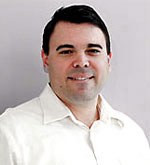The Texas Analog Center of Excellence at UT Dallas has awarded nearly $1.7 million in grants to Texas researchers to develop new technology for solar cells, biosensors, implantable heart defibrillators and much more.

Dr. Eric Vogel
“The primary theme of these three-year grants is to address grand challenges from the semiconductor industry’s International Technology Roadmap for Semiconductors,” said Dr. Eric Vogel, associate director of TxACE and an associate professor of materials science and engineering at UT Dallas. “Addressing the challenges in the ITRS requires circuit design research in three main areas: management and optimization of circuit power and energy, design of robust circuits and design of high-performance circuits.”
All of the projects are expected to have ramifications that extend well beyond their initial focus.
“Our broad goal is to fund projects that not only address important needs in areas such as health care and power generation but also extend the state of the art in analog semiconductor technology,” said TxACE’s director, Dr. Ken O.
The $150,000 biosensor project aims to create a means to perform computing at the cellular level that can recognize multi-gene disorders, including cancers and hereditary diseases. The resulting cellular sensing mechanism would then pass its results along to an external device, leading to “a highly selective tool for diagnosis and treatment,” according to Dr. Leo Bleris, an assistant professor of electrical engineering at UT Dallas and principal investigator for the project.
The $180,000 defibrillator project focuses on creating ultra-low-power analog circuits that greatly extend an implanted defibrillator’s battery life. The principal investigator is Dr. Donald Lie of Texas Tech University, and the results will probably be applicable to many other implantable devices such as pacemakers.
The $180,000 solar cell project is intended to develop new methods and integrated circuit architectures to fully integrate solar-energy-harvesting circuitry into a single chip. Led by Dr. Arjang Hassibi of UT Austin, that should lower production costs and increase the life of solar cells.
The other six funded projects and their principal investigators are:
- “Energy Efficient Comparator Elements for A/D and High-Speed I/O,” Dr. Vojin Oklobdzija, UT Dallas.
- “A Fully-Integrated CMOS Platform for Microwave-Based Label-Free DNA Sensing,” Dr. Kamran Entesari, Texas A&M.
- “High Accuracy All-CMOS Temperature Sensor with Low-Voltage Low-Power Subthreshold MOSFETs Front-End and Performance-Enhancement Techniques,” Dr. Changzhi Li, Texas Tech.
- “Hierarchical Model Checking for Practical Analog/Mixed-Signal Design Verification,” Dr. Peng Li, Texas A&M.
- “Power-Efficient 10-20GS/s ADCs for High-Speed Communications,” Dr. Jin Liu, UT Dallas.
- “Design Techniques for Scalable, Sub-1mW/Gbps Serial I/O Transceivers,” Dr. Sam Palermo, Texas A&M.
Dedicated to help create leading-edge analog technology for both traditional electronics and emerging applications, TxACE is specifically focused on improving energy efficiency, healthcare, and public safety and security. A collaborative effort by Semiconductor Research Corp., the state of Texas through its Texas Emerging Technology Fund, Texas Instruments Inc., the UT System and UT Dallas, TxACE has awarded more than $7 million in research funding in its first two years and has become the largest analog research center in the world.